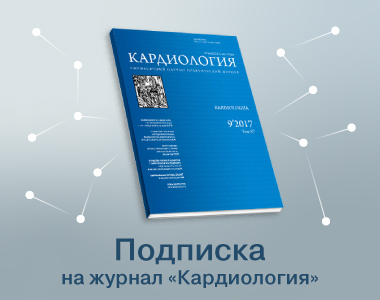Results of the Registry of Patients With Atrial Tachyarhythmias After Interventional Treatment (RPATIT)
https://doi.org/10.18087/cardio.2025.4.n2803
Abstract
Aim To study the long-term clinical profile of safety and efficacy of anticoagulant therapy (ACT) in patients with atrial tachyarrhythmias (AT) after interventional treatment.
Material and methods A total of 5,611 medical records of patients managed in the Department of Surgical Treatment of Complex Heart Rhythm Disorders and Electrical Pacing of the Cardiology Research Institute of Tomsk National Research Medical Center (TNRMC) from 01.01.2017 through 31.12.2019 was analyzed. The study included 1,342 of the patients with various forms of AT who underwent the catheter treatment for heart rhythm disorders.
Results The administration of ACT to patients with AT after the interventional treatment is safe, since the combined use of an invasive strategy and ACT does not increase the risk of major and minor bleeding. The effective intervention allows significantly reducing the risk of ischemic stroke in patients with paroxysmal and persistent atrial fibrillation and virtually completely excluding the likelihood of other thromboembolic complications.
Conclusion Successful radiofrequency ablation/cryoballoon ablation of atrial fibrillation foci significantly reduces the risk of ischemic stroke, while the invasive strategy does not increase the risk of major and minor bleeding.
About the Authors
O. R. EshmatovRussian Federation
PhD researcher, Laboratory of High Technologies for Diagnosis and Treatment of Cardiac Arrhythmias
R. E. Batalov
Russian Federation
PhD, head Laboratory of High Technologies for Diagnosis and Treatment of Cardiac Arrhythmias
M. S. Khlynin
Russian Federation
PhD, researcher, Laboratory of High Technologies for Diagnosis and Treatment of Cardiac Arrhythmias
E. A. Archakov
Russian Federation
PhD, researcher, Laboratory of High Technologies for Diagnosis and Treatment of Cardiac Arrhythmias
References
1. Wann LS, Curtis AB, January CT, Ellenbogen KA, Lowe JE, Estes NA et al. 2011 ACCF/AHA/HRS focused update on the management of patients with atrial fibrillation (Updating the 2006 Guideline): a report of the American College of Cardiology Foundation/American Heart Association Task Force on Practice Guidelines. Heart rhythm. 2011;8(1):157–76. DOI: 10.1016/j.hrthm.2010.11.047.
2. Connolly SJ, Ezekowitz MD, Yusuf S, Eikelboom J, Oldgren J, Parekh A et al. Dabigatran versus warfarin in patients with atrial fibrillation. The New England journal of medicine. 2009;361(12):1139–51. DOI: 10.1056/NEJMoa0905561.
3. Granger CB, Alexander JH, McMurray JJ, Lopes RD, Hylek EM, Hanna M et al. Apixaban versus warfarin in patients with atrial fibrillation. The New England journal of medicine. 2011;365(11):981–92. DOI: 10.1056/NEJMoa1107039.
4. Patel MR, Mahaffey KW, Garg J, Pan G, Singer DE, Hacke W et al. Rivaroxaban versus warfarin in nonvalvular atrial fibrillation. The New England journal of medicine. 2011;365(10):883–91. DOI: 10.1056/NEJMoa1009638.
5. Calkins H, Reynolds MR, Spector P, Sondhi M, Xu Y, Martin A et al. Treatment of atrial fibrillation with antiarrhythmic drugs or radiofrequency ablation: two systematic literature reviews and meta-analyses. Circulation. Arrhythmias and electrophysiology. 2009;2(4):349–61. DOI: 10.1161/CIRCEP.108.824789.
6. Pappone C, Rosanio S, Oreto G, Tocchi M, Gugliotta F, Vicedomini G et al. Circumferential radiofrequency ablation of pulmonary vein ostia: A new anatomic approach for curing atrial fibrillation. Circulation. 2000;102(21):2619–28. DOI: 10.1161/01.cir.102.21.2619.
7. Hindricks G, Potpara T, Dagres N, Arbelo E, Bax JJ, Blomström-Lundqvist C et al. 2020 ESC Guidelines for the diagnosis and management of atrial fibrillation developed in collaboration with the European Association of Cardio-Thoracic Surgery (EACTS): The Task Force for the diagnosis and management of atrial fibrillation of the European Society of Cardiology (ESC) Developed with the special contribution of the European Heart Rhythm Association (EHRA) of the ESC. European heart journal. 2021;42(5):373–498. DOI: 10.1093/eurheartj/ehaa612.
8. Kobza R, Hindricks G, Tanner H, Schirdewahn P, Dorszewski A, Piorkowski C et al. Late recurrent arrhythmias after ablation of atrial fibrillation: incidence, mechanisms and treatment. Heart rhythm. 2004;1(6):676–83. DOI: 10.1016/j.hrthm.2004.08.009.
9. Sauer WH, McKernan ML, Lin D, Gerstenfeld EP, Callans DJ, Marchlinski FE. Clinical predictors and outcomes associated with acute return of pulmonary vein conduction during pulmonary vein isolation for treatment of atrial fibrillation. Heart rhythm. 2006;3(9):1024–8. DOI: 10.1016/j.hrthm.2006.05.007.
Review
For citations:
Eshmatov O.R., Batalov R.E., Khlynin M.S., Archakov E.A. Results of the Registry of Patients With Atrial Tachyarhythmias After Interventional Treatment (RPATIT). Kardiologiia. 2025;65(4):37-41. (In Russ.) https://doi.org/10.18087/cardio.2025.4.n2803

















